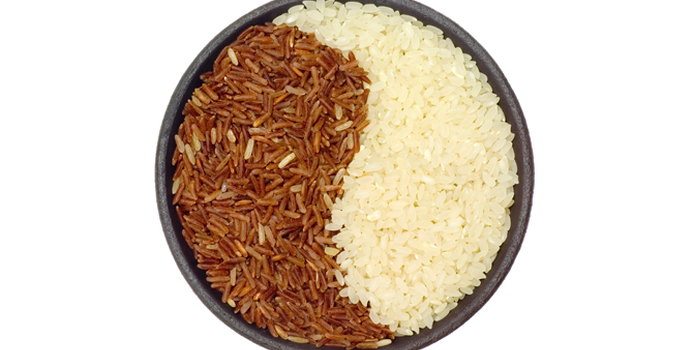You may have heard that brown rice is more nutritious than white rice, but are left wondering if there's really a big difference between the two. Brown and white rice are both starches -- and work well in soups, sushi, casseroles, side dishes, burritos, and stir fry. While the difference between these two types of rice may seem subtle, brown rice is often the healthier choice.
Calorie Content
Brown rice generally contains slightly fewer calories per serving than white rice. The U.S. Department of Agriculture (USDA) National Nutrient Database reports that 1 cup of cooked brown rice provides 218 calories, while cooked white rice contains 242 calories per cup. Therefore, if you're trying to cut calories, brown rice is the better option.
Carbs and Fiber
Brown rice and white rice are both high-carb foods, but brown rice contains fewer overall carbs and more fiber than white rice. The USDA reports that a cup of brown rice provides 46 grams of total carbohydrates, including 4 grams of fiber. One cup of white rice contains 53 grams of carbs, but less than 1 gram of dietary fiber. Because fiber helps boost satiety, aids in healthy weight management, and can help improve blood cholesterol levels, fiber-rich brown rice is again the better choice.
Protein and Fat
Both brown and white rice are low-fat foods, and each provides about 4.5 grams of protein in each 1-cup portion. In other words, these two types of rice don't differ much in terms of protein and fat content.
Vitamins and Minerals
While brown rice naturally contains more vitamins and minerals than white rice because white rice is a refined grain, most white rice varieties are enriched with certain vitamins and minerals -- meaning manufacturers have added nutrients to the rice during processing. Brown and white rice are both sources of B vitamins, and small amounts of iron and zinc. White rice is often a good source of folate.
Glycemic Index
Brown rice has a lower glycemic index (GI) than white rice. According to Harvard Health Publications, the average glycemic index of brown rice is 50, and the average white rice GI is 89. Foods with higher glycemic indexes tend to make your blood sugar rise quickly, but then drop. Lower GI foods don't cause a rapid blood sugar spike, but help you to feel full for longer periods of time.

An experienced health, nutrition and fitness writer, Erin Coleman is a registered and licensed dietitian and holds a dietetics degree from the University of Wisconsin-Madison. She also has worked as a clinical dietitian and health educator in outpatient settings. Erin's work is published on popular health websites, such as TheNest.com and JillianMichaels.com.



